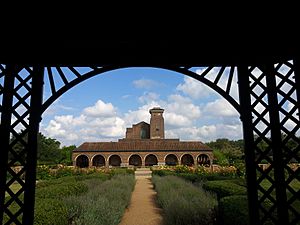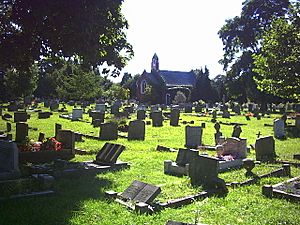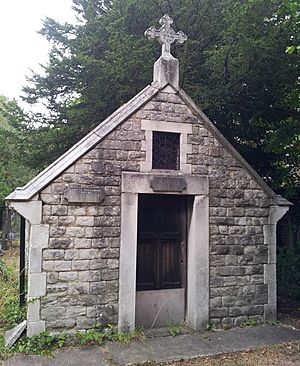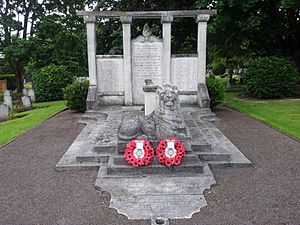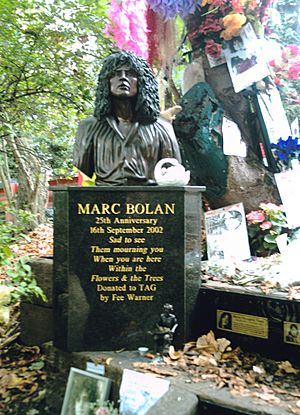List of cemeteries, crematoria and memorials in Richmond upon Thames facts for kids
This is a guide to some special places in the London Borough of Richmond upon Thames where people are remembered. It includes cemeteries (where people are buried), crematoria (where bodies are cremated), and memorials (statues or structures that help us remember people or events). You'll find places managed by Richmond upon Thames Council, and also two cemeteries, Mortlake Cemetery and North Sheen Cemetery, which are looked after by Hammersmith and Fulham Council.
Cemeteries and Burial Grounds
These are places where people are buried. Each one has its own history and special features.
Barnes Cemetery
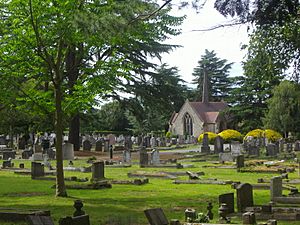
Barnes Cemetery, also known as Barnes Old Cemetery, is a cemetery in Barnes that is no longer used for burials. It was started in 1854. Many important people from the Victorian era were buried here, and you can see various monuments and statues that remember them. In the middle of the cemetery, there is a large memorial for the Hedgman family, who were very kind to the local community in Barnes. The council took over the cemetery in 1966.
East Sheen Cemetery
East Sheen Cemetery, located in East Sheen, opened in 1906. It is now connected to Richmond Cemetery, but a hedge still shows the old border. The cemetery's chapel, built in 1906, is used for services at both cemeteries. It was designed in a Gothic Revival style by Reginald Rowell, an architect who was later buried there himself.
One of the most important monuments in the cemetery is for George William Lancaster, a coal mining industrialist, and his wife. It's a bronze sculpture of an angel crying over a stone tomb, made in the 1920s. This sculpture is considered a very important example of 20th-century art for memorials. The cemetery also has over 70 graves of soldiers from wars, which are cared for by the Commonwealth War Graves Commission.
Hampton Cemetery
Hampton Cemetery, in Hampton, first opened in 1879. It contains the graves of 14 soldiers from World War I and seven from World War II who served in the Commonwealth forces.
Mortlake Cemetery
Mortlake Cemetery is in Kew. It is also known as Hammersmith New Cemetery. It opened in 1926 and is still used today. This cemetery is managed by Hammersmith and Fulham Council. It has the graves of 109 soldiers from World War II. Some of these are in a special area for service personnel.
There is also a memorial wall here that lists 77 Commonwealth soldiers from World War II who were cremated at the nearby Mortlake Crematorium. This memorial is a listed building, meaning it's historically important.
North Sheen Cemetery
North Sheen Cemetery was started in 1909 and is still in use. It is located in Kew. This cemetery is also managed by Hammersmith and Fulham Council. It has 110 identified graves of Commonwealth soldiers from the First and Second World Wars. There is also a special memorial garden here.
Old Mortlake Burial Ground
Old Mortlake Burial Ground, in Mortlake, was established in 1854 and made larger in 1877. It includes the graves of 21 British service personnel from World War I and World War II.
Richmond Cemetery
Richmond Cemetery, in Richmond, opened in 1786 and has been made bigger several times. Many famous people are buried here. It also has the graves of 39 soldiers who died at a hospital in Richmond Park during World War I. Many former service members from the nearby Royal Star and Garter Home are also buried here.
These residents are remembered by the Bromhead Memorial. The South African soldiers are remembered by a special memorial called a cenotaph. This cenotaph was designed by Sir Edwin Lutyens, who also designed the famous Cenotaph in central London. The war graves and the cenotaph are looked after by the Commonwealth War Graves Commission.
Teddington Cemetery
Teddington Cemetery is a historically important cemetery in Teddington. It opened in 1879. It contains the war graves of 70 Commonwealth service personnel: 42 from World War I and 28 from World War II.
Twickenham Cemetery
Twickenham Cemetery is a cemetery in Whitton. It was established in 1868 and was made larger in the 1880s. This happened when the burial grounds at local churches were closed to new burials.
Vineyard Passage Burial Ground
Vineyard Passage Burial Ground is a cemetery in Richmond. It was started in 1790 and officially blessed in 1791. It was made larger in 1823. The last burials here were in 1874. Today, it is managed by Richmond upon Thames Council and volunteers, and it is a peaceful garden of rest. It has a special monument to English architect Thomas Cundy (senior) and his wife. The brick walls and iron railings around the cemetery are also historically important.
Crematoria
A crematorium is a place where bodies are cremated instead of buried.
Mortlake Crematorium
Mortlake Crematorium in Kew was officially allowed to operate in 1936. It was the first crematorium in England to be set up by its own special law. It opened in 1939. Since 2011, it has been a historically important building because of its unique Art Deco design. It still looks much like it did when it was first built.
Mausoleums
A mausoleum is a large, impressive building where people are buried, often above ground.
Comte de Vezlo Mausoleum
The Comte de Vezlo Mausoleum is in the churchyard of St Mary Magdalen Roman Catholic Church, Mortlake. It remembers a very young boy, Guilaume Henri, the Comte de Vezlo (1894–1901). A small sign nearby also remembers his mother, Annette Rosamonde Blasio, who died in 1938.
Kilmorey Mausoleum
The Kilmorey Mausoleum, in St Margarets, looks like an ancient Egyptian monument. It is known for its beautiful inside. It was designed by Henry Edward Kendall Jr. in the 1850s. It was built for Francis Needham, the 2nd Earl of Kilmorey, and contains the bodies of the Earl and his partner, Priscilla Anne Hoste.
Mausoleum of Sir Richard and Lady Burton
The Mausoleum of Sir Richard and Lady Burton is in the churchyard of St Mary Magdalen Roman Catholic Church Mortlake. It is a tent-shaped mausoleum made of Carrara marble and stone. It was finished in 1891. It holds the tombs of the famous Victorian explorer Sir Richard Burton (1821–1890) and his wife Isabel, Lady Burton (1831–1896), who designed it. Sir Richard Burton was known for exploring and for translating The Arabian Nights.
War Memorials
These memorials remember soldiers who died in wars.
Hampton Wick War Memorial
The Hampton Wick War Memorial, in Hampton Wick, was officially revealed in 1921. It has been a historically important monument since 2015.
Richmond War Memorial
The Richmond War Memorial, in Richmond, was officially revealed in 1921. It has been a historically important monument since 2017.
South African War Memorial
The South African War Memorial in Richmond Cemetery was designed by architect Sir Edwin Lutyens. It is a cenotaph, which is a monument to people buried elsewhere, similar to the one in central London. This memorial remembers the 39 South African soldiers who died from their injuries at a military hospital in Richmond Park during World War I. It was officially revealed by General Jan Smuts in 1921 and has been a historically important monument since 2012.
Other War Memorials
- The Kew War Memorial, near St Anne's Church, was revealed in 1921 and is historically important.
- The Mortlake and East Sheen War Memorial, in East Sheen, was revealed in 1925 and is historically important.
- The Petersham War Memorial, in the churchyard of St Peter's Church, was revealed in 1920 and is historically important.
- The Teddington War Memorial, in Teddington, was revealed in 1921 and is historically important.
- The Twickenham War Memorial in Radnor Gardens was designed by Mortimer Brown and put up in 1921. It is a very important historical monument.
Other Memorials
These memorials remember different people or events.
Bromhead Memorial
The Bromhead Memorial is a historically important memorial in Richmond Cemetery. It remembers people who lived at the nearby Royal Star and Garter Home. This memorial was a gift from the Bromhead family. It was designed by Cecil Thomas.
Marc Bolan's Rock Shrine
Marc Bolan's Rock Shrine is a memorial to Marc Bolan, the lead singer of the glam-rock band T-Rex. It is located where he died in a car crash in Barnes on September 16, 1977. This site is recognized as an important place for rock and roll history in England.
Memorials in Richmond Park
There are several memorials within Richmond Park.
- Trees: Many groups of trees have been planted to remember special events. For example, the Jubilee Plantation was planted in 1887 to celebrate Queen Victoria's Golden Jubilee. The Queen Mother's Copse was planted in 1980 for her 80th birthday. After big storms in 1987 and 1990, a new area called Two Storms Wood was planted.
- James Thomson: A bench called "Poet's seat" is in Pembroke Lodge Gardens. It has lines from the poet James Thomson (1700–1748). There's also a wooden plaque remembering him. King Henry's Mound in the park also has lines from Thomson's poem "The Seasons."
- Ian Dury: In 2002, a "musical bench" was placed in a favorite spot of rock singer Ian Dury (1942–2000). The bench has the words "Reasons to be cheerful" from one of his songs. In 2015, the bench was updated. Now, if you scan a QR code with a smartphone, you can listen to some of his songs and an interview he gave.


